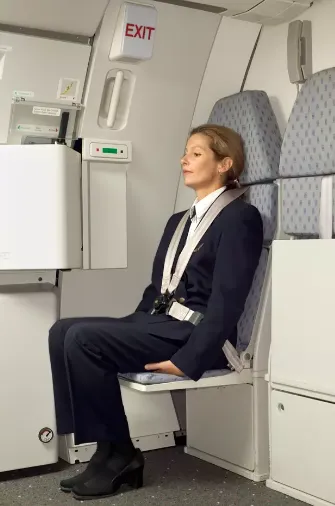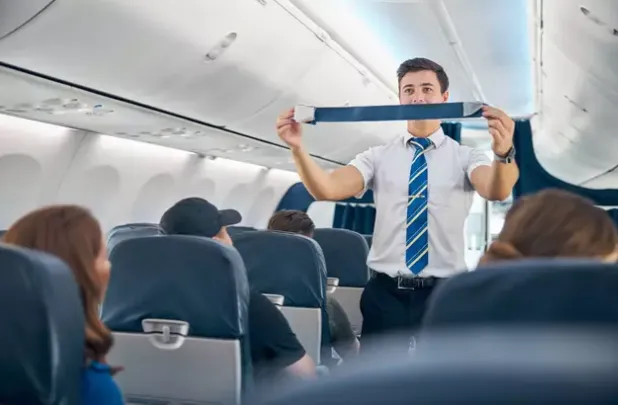The brace position is a vital safety posture that flight attendants use to minimize injuries during takeoff and landing.
A common sight: why do flight attendants sit on their hands?
If you’ve ever flown, you may have noticed a curious sight. As the plane prepares for takeoff or landing, flight attendants buckle up, then sit on their hands.To many passengers, it might look odd or unnecessary.
Is it for comfort? Is it because the cabin is cold? The truth is: it’s part of their brace position—a trained safety posture followed globally in the aviation industry.
Sitting on their hands isn’t random. It’s taught during flight attendant training and is a part of official operating procedures.
In an emergency, seconds matter. This position helps reduce body movement and ensures the crew is alert, steady, and ready to respond.

What is the brace position in aviation?
The brace position is a specific body posture designed to reduce injury during an impact.
It helps protect the spine, head, and limbs. Flight attendants are taught to assume this position during taxi, takeoff, approach, and landing.
Here’s what the flight attendant version includes:
- Seatbelt fastened tightly
- Sitting upright with a straight back
- Hands placed under the thighs, palms facing up
- Arms relaxed
- Feet flat on the floor, shoulder-width apart
According to Henny Lim, a flight attendant for Cebu Pacific, this posture keeps the body in a rigid form.
If there’s an impact, the body won’t be flung around as violently, reducing the chance of serious injuries.
“The aim is to keep the body in a rigid pose so that if there was any impact, the body is damaged less,” Lim explained.
This technique is backed by studies and airline safety research. By limiting unnecessary movement, the body can better absorb shocks and avoid hitting nearby structures.
Why the brace position is crucial for flight attendants

Unlike passengers, flight attendants don’t just sit still during flights.
Their job demands constant awareness, quick reactions, and readiness to help others.
That’s why the brace position plays such a key role in cabin safety.
Anusha Pratima, a flight attendant who shared her insight on Quora, explained:
“While we are seated on the jumpseat during taxiing, takeoff, and landing, we must always be alert for any dangerous situations. Brace positions restrict limb and spine movement, allowing less damage during impact.”
By sitting on their hands, attendants also stop themselves from instinctively reaching out or flailing during turbulence or sudden deceleration.
This reduces the risk of broken fingers, sprains, or worse.
Some airlines today have adjusted their rules. Newer guidelines allow crew to rest their hands on their laps instead of underneath them.
Still, many crew members prefer the traditional method, finding it safer—or simply more comfortable, especially on colder flights.
How passenger and flight attendant brace positions differ
Passengers also receive instructions to assume the brace position in case of an emergency.
However, their version is noticeably different from what the crew does.
For passengers, the general instruction is:
- Bend forward as much as possible
- Place your head against the seat in front of you
- Put your hands flat on the back of the seat or cradle your head
- Keep your feet flat on the floor
This posture protects the head and neck and keeps the torso low to avoid flying objects.
Flight attendants, however, must stay upright. Their priority is to be alert and positioned to assist in evacuation.
Their brace position is designed to protect them while also allowing them to spring into action immediately.
The difference in positioning reflects the roles each group plays during an emergency.
While passengers focus on individual survival, crew members must prepare to assist and lead evacuation efforts if necessary.

Sitting on hands: a habit with purpose
To some, sitting on hands might seem like a quirky habit. But for flight attendants, it’s a calculated move.
Placing the hands under the thighs keeps arms from flying outward during a crash.
It also protects the hands themselves from injury. Some crew members continue the practice even if their airline no longer requires it.
As Anusha humorously shared:
“It’s always freezing and I need to warm my hands.”
While comfort may play a small role, the real reason lies in safety.
The brace position—including the act of sitting on hands—can prevent broken fingers, dislocated shoulders, and serious internal trauma.
It’s a small adjustment that can save lives in high-stakes situations.
The brace position may seem simple, but it’s essential to aviation safety. For flight attendants, it’s more than training—it’s second nature.
It protects them from harm and ensures they’re ready to help others in an emergency.
Next time you see a flight attendant sitting on their hands, remember: it’s not a casual choice.
It’s a practiced, intentional action that could make all the difference when seconds count.